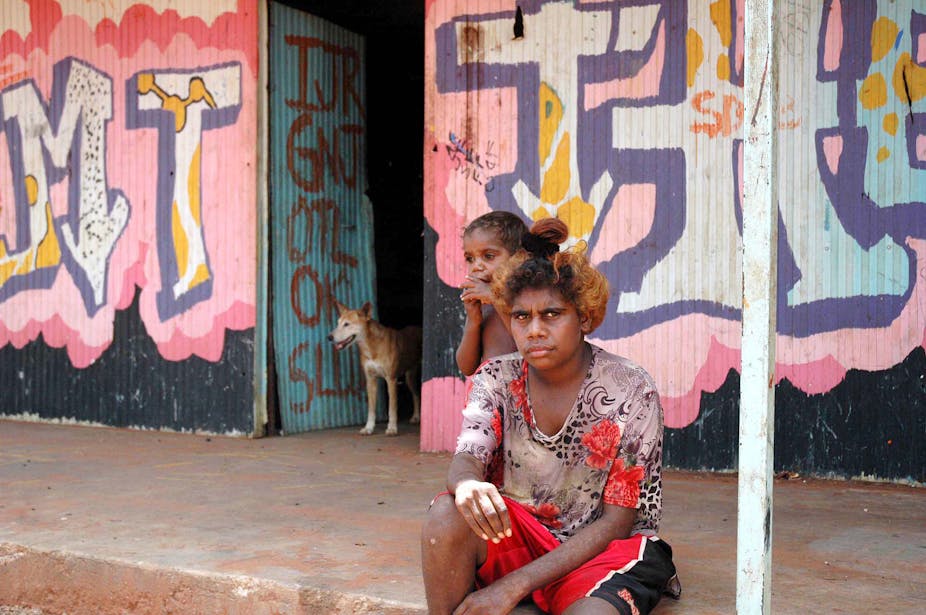on the shore we wait
for the tide to turn
in nights light it recedes
and the fish are gone
In Australia there are many different views about the historical and current role of Aboriginal people in the national landscape.
This view fluctuates. The successes that Aboriginal people have achieved recently are easily embraced. Australians celebrated the success of The Sapphires movie, the success of Alexis Wright in the Miles Franklin literary awards, which she won in 2007 and has been shortlisted for again this year, and Adam Goodes as Australian of the Year.
Yes, Australians all let us rejoice, For we are young and free is the catch cry when everyone celebrates our progress. We can enjoy the feeling of a carefree happiness. It brings a united pride to the fore.
The diversity of Aboriginal people is an achievement we could all be proud of. From the traditional ways to the modern we now boast doctors and lawyers, nurses and teachers, builders and designers, and actors, authors, film makers, musicians of world class standards. We can even celebrate opera singers!
Most Aboriginal people work to give back to our community. We work to improve all aspects of life for our children and grandchildren, and to promote a better understanding of our cultural values. We work endlessly to cross the divide. And for us, culture is the key.
Of course there are some people who are not community focused, as in any society. From my personal experience, I can only calculate that this minority comprises those who have rejected culture. This is as confusing for Aboriginal people as it is for mainstream. But I reiterate, this is a minority of our mob.
However, the less enticing stories such as racism in sport, educational failures, and the refusal to include the Aboriginal historical wars in the Australian War Memorial quickly show a divide between black and white Australia. This is The Great Divide we need to address. This is “closing the gap” on a national psychological and social agenda.

So how does The Great Divide sit on our landscape? It is important to always remember that many Aboriginal people’s lives are still governed by bureaucracy, and for many of us, the decision-making process has been removed from our lives.
Many of my family live trapped inside a system that does not promote health and harmony. For those of us who do enjoy some freedoms, we are rarely asked to share our insights. The lack of proper consultations with Aboriginal people is a national shame. And even in my later years, when I am less able to travel for work, I will probably have to regress back to a system that does not value me, to die.
The Intervention is one example of all of the above. This was a Federal Government initiative that was conceived in 2007 with little consultation with Aboriginal people, and no regard to our psychological or social welfare.
The National Emergency Response, as it is formally known, required an exemption from the Racial Discrimination Act to allow its procession. I believe this law was passed in the middle of the night in Parliament by John Howard and a covert few, and had landed on our doorsteps before the newspapers had reached our front doors.

The justification was pinpointed to an inquiry into child abuse in 2007 titled Little Children Are Sacred Report. There are always concerns regarding child abuse in Aboriginal and mainstream Australia. Some 97 direct recommendations were made, stipulating the need for local based action to protect Aboriginal kids. Yet only two out of 97 recommendations were upheld. No-one agrees with child abuse, only the very depraved. If the governments were serious about this issue, surely more recommendations would have been forthcoming.
Similar reactions occurred following the Royal Commission into Aboriginal Deaths In Custody in 1991 and the Bringing Then Home Report in 1997, the national inquiry into the Separation of Aboriginal and Torres Strait Islander Children from Their Families.
Both these reports were reputedly designed to reduce death and despair in Aboriginal society. Only three of 54 recommendations were undertaken to cater the needs of Stolen Generations people. Aboriginal families know that The Deaths In Custody issue continues, despite 339 recommendations; many that were never set in place.
Approximately 600 soldiers were used to deliver the “bad news” – that local Aboriginal Councils were to be disbanded, that wages and welfare would be quarantined, that all Aboriginal children were required to undergo medical checks by strangers to their community and community development employment projects (CDEP) reduced to a minimum.
At the time, I was living on the edge of the Simpson Desert and saw the arrival of the army with my own eyes. There was much confusion and fear, especially in remote communities where English is often the second language. At Titjikala no local interpreters were employed to lessen this fear and confusion.
Political arguments favour the Intervention, for welfare provision, law enforcement, and land tenure. For me, in my regular visits back to see family and friends in central Australia, I can only interpret welfare provisions equal lack of meaningful employment, law enforcement equals increased incarceration rates and land tenure equals continued theft of land for mining.
This is The Great Divide, this is the illness that sits on the nation’s psychological and social landscape. Despite all achievements in the past 220 years since the arrival of Captain Cook, it is still a Land War.
Ali Cobby Eckermann is an Aboriginal author and poet. She is currently the Artist in Residence at the Faculty of Education and Social Work at the University of Sydney. She will be speaking with Henry Reynolds about the Northern Territory intervention at the Sydney Writers Festival on May 23.

